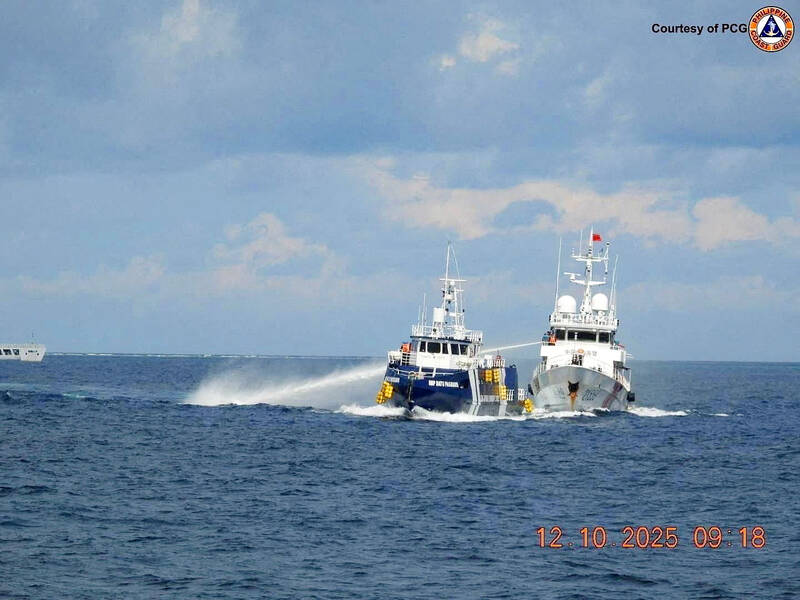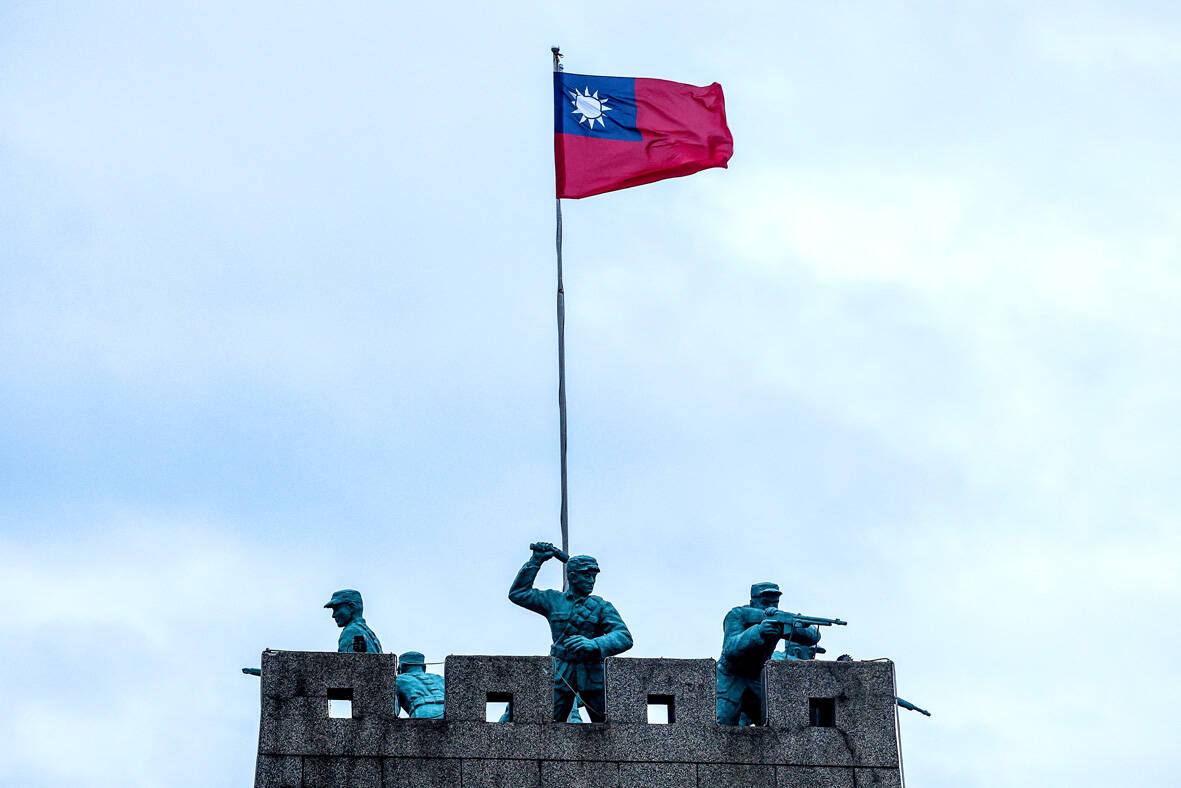Many people noticed the flood of pro-China propaganda across a number of venues in recent weeks that looks like a coordinated assault on US Taiwan policy. It does look like an effort intended to influence the US before the meeting between US President Donald Trump and Chinese dictator Xi Jinping (習近平) over the weekend.
Jennifer Kavanagh’s piece in the New York Times in September appears to be the opening strike of the current campaign. She followed up last week in the Lowy Interpreter, blaming the US for causing the PRC to escalate in the Philippines and Taiwan, saying that as the US has expanded its military infrastructure in the Philippines, for instance, “China ramped up its armed confrontations with the Philippines’ Coast Guard in the South China Sea. As the United States placed military trainers on Taiwan and increased its defense cooperation with the island, Beijing intensified the military and economic pressure it directs daily across the Taiwan Strait.”
In reality, causation runs the other way.

Photo: Reuters
This ahistorical blame of the US for the expansionism of the People’s Republic of China (PRC) is a by-the-numbers, pro-PRC propaganda move. Kavanagh is at Defense Priorities and a former member of the Carnegie Endowment for International Peace, an institution rife with pro-PRC writers.
She also once worked for the US-based RAND Corp think tank, which last week came out with one of the most absurd RAND documents I have ever read (I have been following RAND since the early 90s): “Stabilizing the US-China Rivalry.” Its recommendations were largely pro-PRC. Why? As analyst Kaori Fujisawa pointed out on Bluesky, its “‘balanced’ contributors include PRC-affiliated scholars such as Jie Dalei (節大磊, Peking University) and Feng Zhang (Australian National University, but previously with Chinese institutes tied to the United Front).”
The report was funded by Peter Richards, who has connections to the notoriously pro-PRC Quincy Institute.

Photo: AFP
Lyle Goldstein, who has been writing pro-PRC pieces on Taiwan for roughly a decade now, joined the chorus in Time late last month, with a piece blaming President William Lai (賴清德) for ramping up tensions in the Taiwan Strait, a pro-PRC move that dates back to the hoary days of President Chen Shui-bian (陳水扁): “American leaders should not hesitate to rein in Taiwan’s evidently reckless leader.”
Goldstein, like Kavanagh, is affiliated with Defense Priorities.
Painting Taiwan’s leaders as “reckless” sows the ground by making a moral case for a US abandonment of Taiwan that shifts the blame to Taiwan for resisting PRC annexation: “hey, they were reckless!” Variations on this approach have become common the last few years. For example, the accusation that Taiwan does not spend enough on defense has an obvious corollary: the US should abandon it if spending isn’t increased (and it is morally ok to do so — it’s Taiwan’s fault, right?).
Time also published a piece by a retired PRC military officer on Oct. 23, while the Telegraph in the UK added another screed from the PRC ambassador to the UK last week. No need to discuss them.
Stephen Wertheim, another sellout advocate whose arguments I explored last year (“The Emerging Sellout Argument,” Nov. 24, 2024), popped up again in Foreign Policy (“How Trump and Xi Can Pull Back From the Brink,” Oct. 28, 2025) with a more heavily obscured argument for selling out Taiwan. Wertheim’s argument is simple: “Washington will not support Taiwan’s independence or rule out peaceful unification with the mainland, and in return, Beijing will avoid the use of force and ease its military intimidation of Taiwan.”
His piece contains clear PRC propaganda markers, including the odious “permanent separation” of Taiwan from China, a phrase that peppers pro-PRC writing. Taiwan has never been part of China, and isn’t now under both US policy and international law. Wertheim never describes US policy, but his proposal is a violation of Washington’s current position that Taiwan’s status remains unresolved, which is also Taiwan’s status under international law.
Wertheim’s contention that the US should say it does not support Taiwan independence has the same problem that all the pro-PRC variations on US policy changes do: they render US policy incoherent. If US policy does not make room for an outcome that creates an independent Taiwan, then why bother to invest in fighting for it? To prevent China from violently annexing Taiwan? Then the US position is rendered absurd — the US would make war to prevent war. Silly. This same contradiction, appearing in the writings of other pro-PRC commentators, is inherent in any pro-PRC change to US policy.
What the Wertheim piece is actually doing is searching for a language that will render the US position on Taiwan incoherent without appearing to do so, and without requiring the PRC to do anything meaningful to reduce its threat to the people of Taiwan. The obvious next step is then to argue that since the US position now makes no sense, the US should abandon Taiwan.
The push isn’t for peace or stability in the Taiwan Strait, but for US acceptance of PRC occupation of Taiwan. Saying that the US will not support Taiwan independence is tantamount to accepting that Taiwan is part of China. It is sneaking in a victory for the PRC by the back door.
Wertheim, it almost goes without saying, is affiliated with the Carnegie Endowment.
If Kavanagh, Wertheim and Goldstein truly want to identify the reckless party disturbing the peace in the Taiwan Strait, they might point fingers at Bejing and its constant flow of “gray zone” warfare, cyberattacks and suppression of Taiwan’s presence in the world, along with its expansion against other nations and its enormous military build up. They might also highlight the behavior of the Chinese Nationalist Party (KMT), which has cut defense spending, put up roadblocks to the development of military-civil fusion programs for civil defense and aligned itself with the PRC (a KMT official was just sent to China by the new, wildly pro-China KMT chairwoman). Weakening Taiwan’s defense is a temptation to the PRC to take action, far more dangerous than Lai’s boilerplate statements of ROC sovereignty.
It’s always important to note what’s missing in these pieces: the Taiwan people themselves. As Mark Harrison observed on X: “Anyone in Washington or Beijing proposing “peaceful reunification” between Taiwan and China needs to explain what they are seeing in the last 200 years of Taiwanese history that makes them think this is possible.”
Taiwan has its own agency, and isn’t going to go quietly into that good night.
Also AWOL are the nations around Taiwan, who will become targets of further violent expansion by Beijing if it occupies Taiwan. Of course, the Taiwanese military will be expended to advance that goal. Recall that Tokyo and Manila both have formal defense treaties with the US. What Wertheim et al advocate is a world where, a decade or two from now, good Taiwanese boys die fighting the US as it moves to protect its allies from Beijing’s depredations.
One thing I’ve learned in 25 years of responding to pro-PRC propaganda is that it never stops, and is always the same: it always calls for weakening the US position on Taiwan as the first step to abandoning it, and it never demands that the PRC make any meaningful changes.
The emerging sellout argument has now emerged, a vampire from its crypt. It will, in the end, feed on blood.
Notes from Central Taiwan is a column written by long-term resident Michael Turton, who provides incisive commentary informed by three decades of living in and writing about his adoptive country. The views expressed here are his own.

Exceptions to the rule are sometimes revealing. For a brief few years, there was an emerging ideological split between the Democratic Progressive Party (DPP) and Chinese Nationalist Party (KMT) that appeared to be pushing the DPP in a direction that would be considered more liberal, and the KMT more conservative. In the previous column, “The KMT-DPP’s bureaucrat-led developmental state” (Dec. 11, page 12), we examined how Taiwan’s democratic system developed, and how both the two main parties largely accepted a similar consensus on how Taiwan should be run domestically and did not split along the left-right lines more familiar in

As I finally slid into the warm embrace of the hot, clifftop pool, it was a serene moment of reflection. The sound of the river reflected off the cave walls, the white of our camping lights reflected off the dark, shimmering surface of the water, and I reflected on how fortunate I was to be here. After all, the beautiful walk through narrow canyons that had brought us here had been inaccessible for five years — and will be again soon. The day had started at the Huisun Forest Area (惠蓀林場), at the end of Nantou County Route 80, north and east

Specialty sandwiches loaded with the contents of an entire charcuterie board, overflowing with sauces, creams and all manner of creative add-ons, is perhaps one of the biggest global food trends of this year. From London to New York, lines form down the block for mortadella, burrata, pistachio and more stuffed between slices of fresh sourdough, rye or focaccia. To try the trend in Taipei, Munchies Mafia is for sure the spot — could this be the best sandwich in town? Carlos from Spain and Sergio from Mexico opened this spot just seven months ago. The two met working in the

This month the government ordered a one-year block of Xiaohongshu (小紅書) or Rednote, a Chinese social media platform with more than 3 million users in Taiwan. The government pointed to widespread fraud activity on the platform, along with cybersecurity failures. Officials said that they had reached out to the company and asked it to change. However, they received no response. The pro-China parties, the Chinese Nationalist Party (KMT) and Taiwan People’s Party (TPP), immediately swung into action, denouncing the ban as an attack on free speech. This “free speech” claim was then echoed by the People’s Republic of China (PRC),